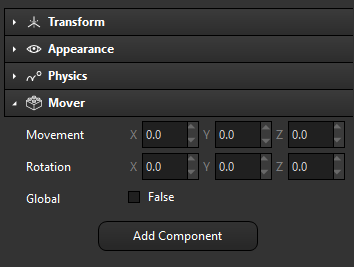Component
The Ultra Engine entity component system allows you to easily add behavior to game objects. This class can be extended to add behavior and properties to an Entity.
| Property | Type | Description |
|---|---|---|
| entity | Entity | entity this component is attached to |
| Collide | Method | called whenever a physics collision occurs |
| Copy | Method | makes a copy of the component, for copying entities |
| Load | Method | called when an actor is loaded or copied |
| Save | Method | called when an actor is saved or copied |
| Start | Method | called when a component is added |
| Update | Method | called once each time World:Update is called |
You can override these methods or add your own in your component class. To add a new component, just create a new .lua file in your "Source\Components" folder. You can use separate files if you want, but it is more convenient to put everything in a single file that can be included into your project. Compile your project once and the Lua interpreter will detect your new file and update the component system code. The component system will automatically update the component registration when the Lua interpreter detects changes to the component files.
The Lua interpreter is limited in its ability to parse Lua declarations, so it's a good idea to stick to straightforward Lua syntax.
Using Components
To use components in Lua, create a new Lua script and use the Lua API functions to add the component to an entity with Entity:AddComponent. The game engine will take care of the rest for you:
-- Create a world
local world = CreateWorld()
-- Create a camera
local camera = CreateCamera(world)
camera:SetClearColor(0.125)
camera:SetFov(70)
camera:SetPosition(0, 0, -3)
-- Create a light
local light = CreateBoxLight(world)
light:SetRotation(35, 45, 0)
light:SetRange(-10, 10)
-- Create a box
local box = CreateBox(world)
box:SetColor(0, 0, 1)
-- Entity component system
local mover = box:AddComponent(Mover)
mover.rotationspeed.y = 45
-- Main loop
while not window:Closed() and not window:KeyDown(KEY_ESCAPE) do
world:Update()
world:Render(framebuffer)
endExample Component
The Mover component is about as simple as it gets. It just stores some motion parameters and moves or turns the entity each time Update is called:
Mover = {}
Mover.name = "Mover"
Mover.movementspeed = Vec3(0)
Mover.rotationspeed = Vec3(0,1,0)
Mover.globalcoords = false
function Mover:Start()
end
function Mover:Update()
if self.globalcoords then
self.entity:Translate(self.movementspeed / 60, true)
else
self.entity:Move(self.movementspeed / 60)
end
self.entity:Turn(self.rotationspeed / 60, self.globalcoords)
end
RegisterComponent("Mover", Mover)
return MoverComponent Methods and Members
To call a component method or get a value, first check if a component of the desired type is attached to the entity, and then call the method:
if type(entity.healthmanager) == "table" then
if type(entity.healthmanager.TakeDamage) == "function" then
entity.healthmanager:TakeDamage(10)
end
endExposing Components to the Editor
To display components in the editor, each component must have a JSON file with the same base name as the code file. The format of the JSON data is the same for every supported programming language. Here is the contents of the Mover.json file:
{
"component":
{
"properties":
[
{
"name": "movementspeed",
"label": "Movement",
"value": [0.0,0.0,0.0]
},
{
"name": "rotationspeed",
"label": "Rotation",
"value": [0.0,0.0,0.0]
},
{
"name": "globalcoords",
"label": "Global",
"value": false
}
]
}
}Each property entry represents an editable value that will be displayed in the component properties when it is attached to an entity. The default value of the property determines what type of interface element will be used to control the value.

We can add input and output functions to the component definition.
{
"component":
{
"outputs":
[
{
"name": "Open"
},
{
"name": "Close"
}
],
"inputs":
[
{
"name": "Open"
},
{
"name": "Close"
},
{
"name": "Enable"
},
{
"name": "Disable"
}
]
}
}This will control which component methods can be connected in the flowgraph editor.
